Understanding Calcium Nodules in Pools
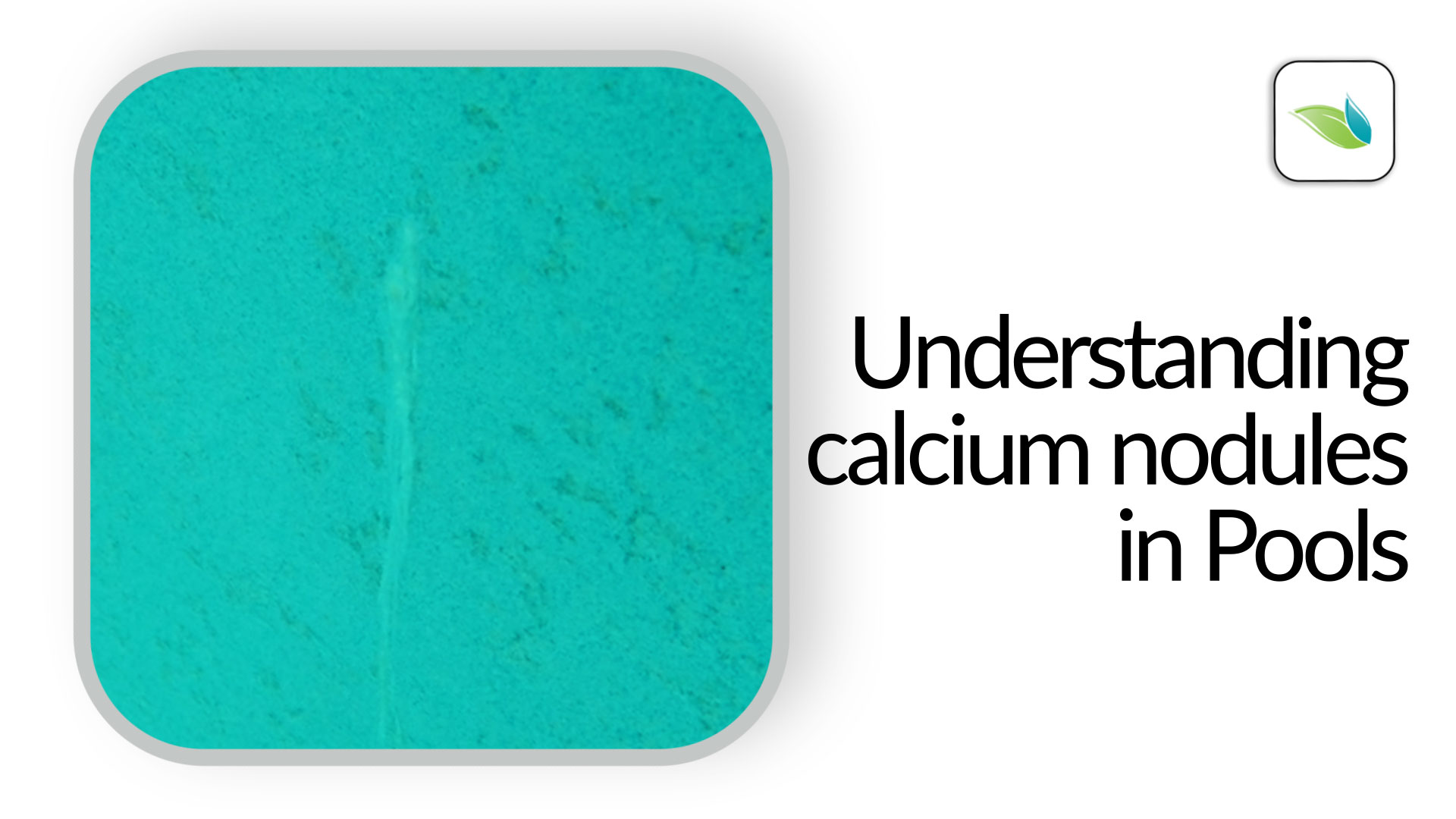
Calcium nodules in pools look like little calcium volcanos or blisters that ooze out of pool walls and floors. While there are varying opinions on this topic, in this article, we will explain what nodules are and why they occur. Then we'll discuss how to prevent and fix calcium nodules.
Covered in this article:
- What are calcium nodules?
- How are calcium nodules formed in swimming pools?
- What are the underlying causes of nodules?
- The facts everyone agrees on
- What causes voids/cracks/other weaknesses?
- Common Denominators
- Research on calcium nodules
- How to fix calcium nodules
- How to prevent calcium nodules
What are calcium nodules?
.png?width=760&height=802&name=nodule%20on%20tile%20grout%20(onBalance%20video).png)
Photo credit: onBalance
Calcium nodules are calcium carbonate formations on pool surfaces that grow out of pores in cement as a result of calcium hydroxide (Ca(OH)2) being pushed out of the cementitious surface toward the pool. That calcium hydroxide then carbonates in the pool water forming calcium carbonate (CaCO3) in the form of a nodule. Much like volcanos are formed from active movement of molten magma, nodules each contain a hollow tunnel where calcium hydroxide pushes through.
Virtually identical chemistry occurs during the formation of calcite crystals (winter crystals), but with the exception that winter crystals occur in cold, stagnant, aggressive, low-LSI water. The aggressive water dissolves the outer calcium carbonate layer of the cement and draws out the calcium hydroxide until it carbonates into crystals.1
Related: Understanding the Langelier Saturation Index (LSI)
Another similar chemistry is plaster dust in the first few days of filling a freshly-plastered swimming pool. Calcium hydroxide leaves the cement, gets carbonated in the water, and calcium carbonate dust lands on the pool surface.
Calcium nodules, however, are different from both plaster dust and calcite crystals. Calcium nodules are NOT a water chemistry issue...in fact, they are unlikely to form in aggressive (low-LSI) water at all, as low-LSI water would keep the calcium soluble. Confused yet? It's okay, just stick with us.
A good way to think of calcium nodules is that they are a type of efflorescence. Instead of calcium hydroxide being pulled out of cement by aggressive water (like crystals), calcium nodules form when calcium hydroxide is pushed out of cement (like efflorescence).
Efflorescence, of course, is when moisture penetrates a cementitious material and transports dissolved minerals and salts with it. Usually, it presents itself as calcium carbonate on the outside of the cement, such as the outside of raised spas (that are not waterproof) or even raised flower beds that allow moisture to push through the cement.
How are calcium nodules formed in swimming pools?
A calcium nodule forms when calcium hydroxide (Ca(OH)2) comes out from within a surface due to some sort of weakness, like a small crack, hole, or void. These calcium compounds then carbonate on the visible surface inside the pool when they interact with:
- carbon dioxide (or carbonic acid, which is dissolved carbon dioxide, H2CO3)
- bicarbonate alkalinity (HCO3-), or
- carbonate alkalinity (CO32-).
Carbonates can turn calcium compounds into calcium carbonate (CaCO3). These deposits will continue to grow out from the weakness in the surface until their source is depleted. Some nodules even get large enough to 'ooze' with gravity. And just like that, you have a calcium nodule.
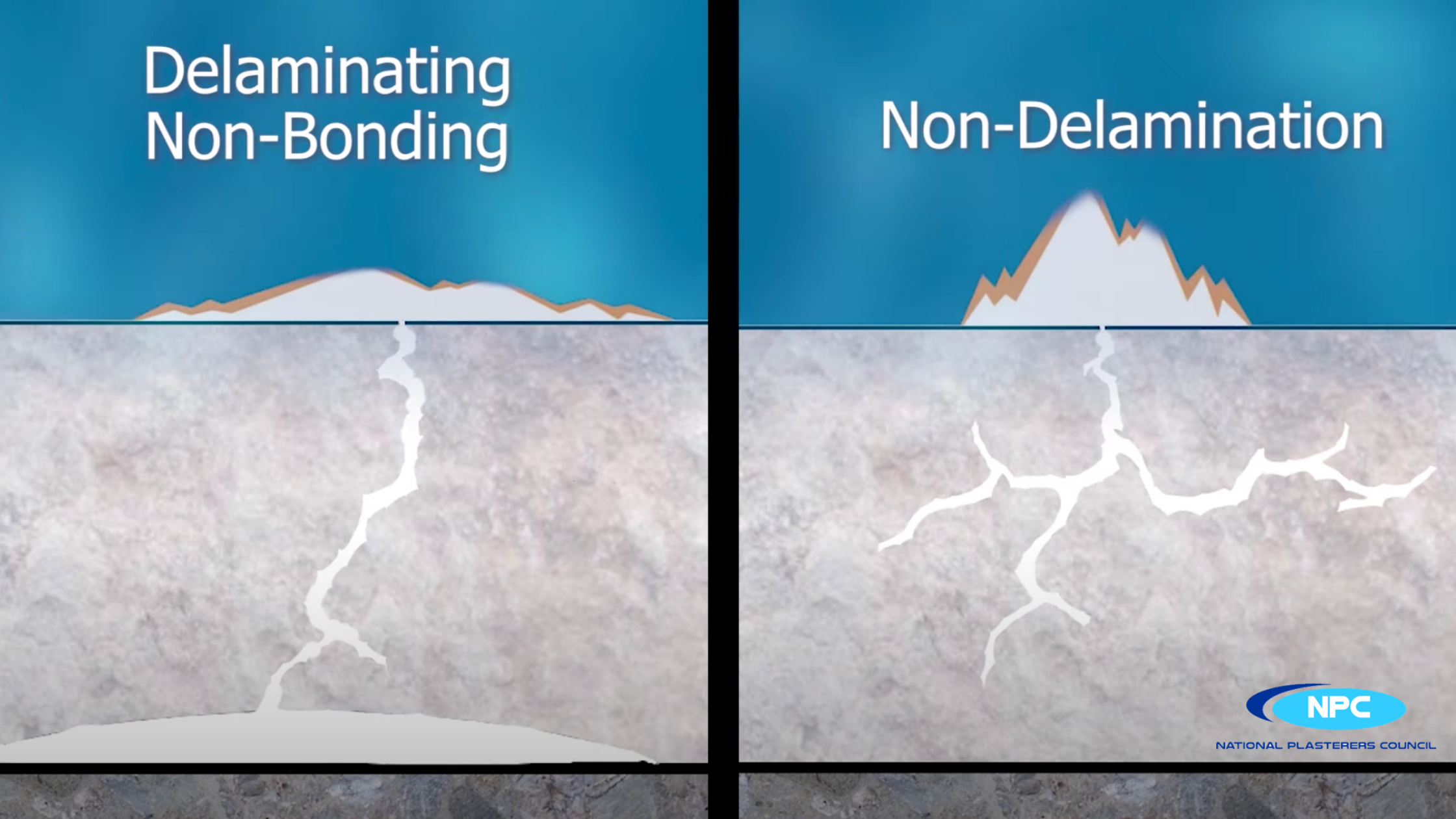
Credit: Screenshot from NPC video
Experts all seem to agree that calcium nodules come from within a cementitious surface. One thing is certain: calcium nodules are not a type of scale, because scale is the result of an over-saturation in the water, and nodules are not. The most prevalent type of scale (by far) is calcium carbonate scale, which forms as the result of a high LSI. This means the water gets oversaturated with calcium carbonate, so it precipitates some out of solution, which forms scale.
Nodules are a different phenomenon entirely and are not caused by a high LSI.
In other words, calcium nodules are not directly caused by water chemistry. Perhaps long-term chemistry can weaken a surface and contribute to the problem over time, but it is not a direct relationship. To create these weaknesses in plaster in the first place, there needs to be an issue with the plaster itself. In our experience–which is reinforced by the lab studies of core samples–water chemistry alone does not cause these voids/holes/weaknesses. Once a weakness is there, aggressive water can make it worse, however.
Related: Understanding the Langelier Saturation Index (LSI)
What are the underlying causes of calcium nodules?
This is where expert opinions begin to conflict. We at Orenda have done our research about nodules and other plaster issues, but we are not original sources of the information. We bring this up to remind everyone that we are not scientists. We rely on field and laboratory research from people far more informed than we are. And we are happy to share their findings with you, used with permission.
So let's start with just the facts about calcium nodules that everyone seems to agree on.
The facts everyone agrees on
- Delamination is a failure of plaster to bond to the concrete pool shell and is not water chemistry related
- Nodules can either be a consequence of delamination or can come from within a surface without delamination
- Nodules form on the surface where voids, cracks, or other weaknesses are located
- Voids, cracks, and other weaknesses in cement allow for calcium compounds to migrate to the surface2
- Calcium compounds in the water carbonate the calcium hydroxide coming out of the cement, which forms the nodules
The items of disagreement are primarily:
- What causes the voids, cracks or weaknesses in the first place?
- Why are these calcium compounds forced into the pool from within the surface?
- How to remedy and prevent nodules
We at Orenda have been focusing less on the details of exactly what caused the weaknesses in the surface, and instead have focused on finding out what steps need to be done to prevent nodules in the first place.
What causes the voids/cracks/other weaknesses?
The argument has been made that aggressive water causes these nodules; both by creating voids and weaknesses in the surface, and by extracting the calcium hydroxide from within it. But based on the evidence from the field and laboratory analysis, we disagree. If that were the case, the calcium coming out of the cement would form dust, just like plaster dust. That, or it would stay soluble because the water itself is aggressive.3
Nodules are clearly forming around the exact hole/void/crack where moisture can push through the surface. We reviewed the research and compared it to our own knowledge of cement chemistry and physics. In our opinion, the aggressive water theory does not hold up. We know of many things that aggressive water can cause, but calcium nodules are not on that list.
In any case, there still needs to be moisture pushing from within or behind the plaster to cause nodules, which we'll elaborate on in a moment.
Research on calcium nodules
Here is onBalance's two-part video explainer on calcium nodules.
The onBalance position is that nodules are not caused by pool chemistry; they are caused by plaster failures. Either it's a bond failure (which NPC agrees can be one of the issues), or the voids/cracks are a result of improper troweling workmanship, water/calcium/cement mix ratio, or something similar. Here's a quote from their website:
"Although some have attempted to associate nodules with aggressive pool water, research has shown that the cause of nodule formation is cracking (from over–drying of the plaster) or bond failure (aka delamination), which occurs primarily in re-plastered pools. Nodules, of course, have nothing to do with pool water chemical balance." 4
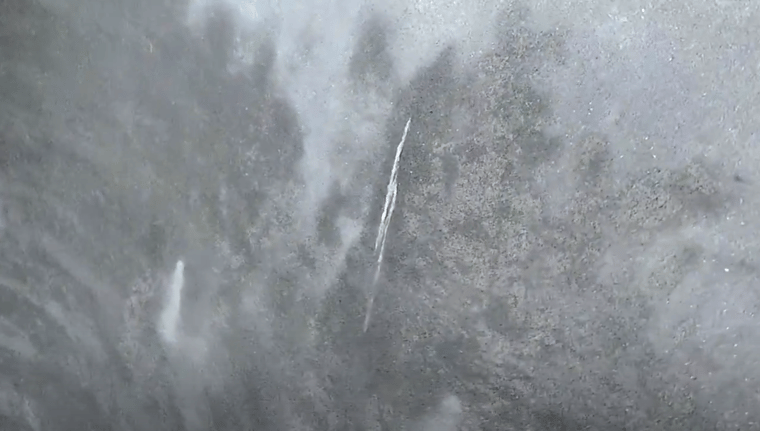
onBalance posits that nodules do not require aggressive water to form. In the case of delamination, there can be enough pressure to push these compounds out into the pool anyway. If there is a void behind the plaster due to a bond failure (delamination), but that void never is exposed to water, if and when water finally gets through a small crack or other weakness, it will begin to chemically interact with the underside of the plaster finish, just like the entire outside of the finish did on startup. This, onBalance argues, leads to nodules too:
"Regardless of whether the void is filled with water immediately or down the road, the process of hydration will occur inside the void just as it did out on the face of the pool when it was new. Only this time the calcium hydroxide is temporarily trapped, allowing it to concentrate – creating a strong, localized body of the material from which a nodule can be made. But it then travels out to the main body of water in the pool where it can react with alkalinity to transform into calcium carbonate. Where does this conversion to non–soluble calcium occur? In our plaster dust example, the conversion occurred uniformly over the entire surface of the plaster, resulting in a uniform fall–out of plaster dust throughout the pool. In the case of super–saturated calcium water oozing out of a pinhole, the conversion occurs just as it exits the void and enters the pool, i.e.: on the plaster surface of the pool."
Here's our take on the onBalance opinion:
We certainly don't know as much as onBalance when it comes to cement chemistry, but we do know a few things for certain. One of them is that aggressive water seeks calcium via the path of least resistance. In other words, water is not likely to 'dig a pinhole' sized cavity into cement, when it can etch a larger surface area more easily. So we agree that aggressive water is not likely the culprit behind causing these plaster failures.
Common Denominators
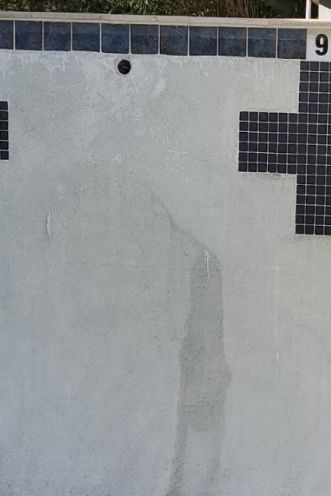 We have been called to countless pools with plaster issues, and to us, nodule pools usually have at least one of these three factors.
We have been called to countless pools with plaster issues, and to us, nodule pools usually have at least one of these three factors.
- First, most of the nodules we see occur along cracks. This makes sense, again, because water always moves through the path of least resistance. In the photo here, you can see water coming from within the surface, all around the nodule. In this case, the wall had delamination issues, and also a major concrete shell problem called weepers. Weepers are basically leaks where water is pushed from behind the pool shell into the pool itself, which of course then pushes through the plaster. Weepers, in our experience, are almost always accompanied by nodules.
- Second, the vast majority of nodule pools are either not waterproofed, are in a high water table area (like coastal regions), or both. We have good customers of ours that have been plagued by nodules, only to discover that their high water table led to pressure from behind the concrete shell. In the past couple of years they have moved to waterproof every shell, and the nodule problem has disappeared for them. We are so happy to hear it, and it gives us optimism.
- The third common factor is replastered pools. Yes, original plaster jobs can have nodules too, but if a pool with calcium nodules is not in a high water table area, and/or was waterproofed, there's a good chance it was replastered. Replastering should be done with a proper bond coat so the new layer can adhere properly. You might be surprised at how often this step is skipped. Here's a photo of a spa that was being chipped out and plastered from scratch, and it had two layers of plaster with a bond coat:
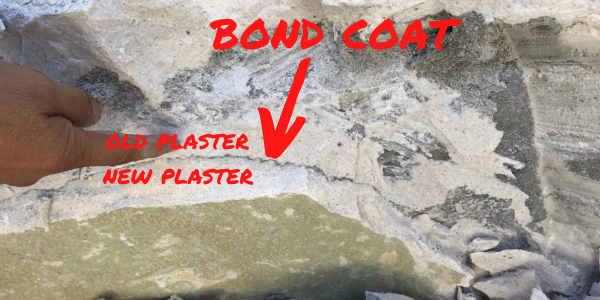
Without a good bond coat, delamination becomes more of a risk, and therefore nodules become more of a risk too.
How to fix calcium nodules
We have good and bad news. The good news is some nodules will eventually run their course, and run out of 'lava' oozing out of the volcano. This can take a few years, but you could just keep sanding them down by hand or grinding them off in the meantime. SC-1000 can also help soften and dissolve the nodules, but it will not solve the root cause, so the nodules will continue to come back until the source 'dries up', so to speak.
The bad news is nodules are a structural issue that cannot simply be cured by good water chemistry. Simply balancing the LSI prevents etching and scale, but nodules are still possible because they grow out of the plaster surface. Many of our customers hope that good water chemistry can prevent calcium nodules from coming back, but we have no evidence to support that.
We really wish water chemistry could solve the problem, but unfortunately, that's not the case with calcium nodules.
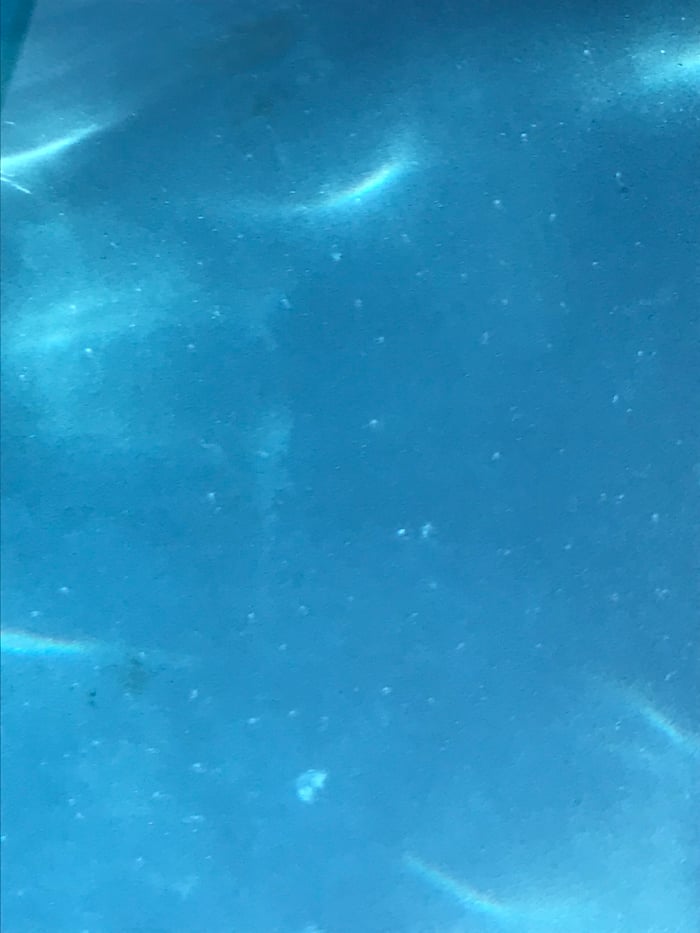
This pool had thousands of tiny nodules on the walls and floor. It was not waterproofed and was located in a coastal area with a high water table.
The last resort to ultimately solve a nodule problem–particularly if there are a lot of them in your pool–is to chip out the plaster, repair any concrete issues with the pool shell, apply a waterproofing/bond coat, then replaster the pool.
To reiterate, we said chip out and replaster, not bond coat and plaster over the old plaster. If you already have nodules, simply bond coating over the old surface does not get to the root cause of the problem. You need to get it all out and start over. Don't treat the symptom; treat the fundamental problem.
How to prevent calcium nodules
Calcium nodule prevention is a matter of a few best practices that need to be done by the pool builder, plaster applicator, and whoever is starting up/filling the swimming pool.
- First, the builder needs to make sure the concrete shell is shot and cured correctly. This means discarding shotcrete rebound and shooting to the proper PSI. It means taking necessary precautions to avoid issues from cold joints and any other weaknesses in the shell. Then it means hydrating the shell properly for enough days so that it cures to its optimal strength and has minimal shrinkage cracks (usually 28 days). It also means waterproofing, especially in areas with a high water table (like coastal areas).
- Second, the plaster applicator needs to mix the plaster with the right ratios and follow best practices for applying the material in the pool. If it's a replaster, this means applying a bond coat correctly if not completely removing the previous surface. Avoid letting a pool sit for too long without water in it, because shrinkage cracks are inevitable, especially in hot climates.
- Third, whoever is filling the pool should do so with the LSI in mind. Feed the water the saturation it needs so it is physically unable to steal calcium hydroxide from the fresh plaster surface. The Orenda Startup™ and onBalance bicarb startup both accomplish this. Doing so will minimize the risk of open voids/pinholes/cracks, and therefore minimize the risk of nodules.
- Finally, communicate with all parties involved. If you're a homeowner reading this, take ownership of your pool project! Whether it's a remodel or new construction, you have the right to demand that certain steps–like waterproofing–be taken with your pool. Sure, you'll pay more for them, but the risk of nodules goes down substantially. The cost of something like waterproofing is a fraction of a replacement plaster job.
We hope this article has helped you understand calcium nodules, and what your options are if you have them. If you have questions, contact us or request a virtual training session with us.
1 Notice we said nodules result from calcium hydroxide being pushed out of the cement, whereas crystals and plaster dust form when calcium hydroxide is pulled out of the cement. There's a huge difference in the two concepts. Aggressive pool water pulls from the cement. But for calcium nodules to form, there needs to be a source of moisture and pressure from behind the cement to push it out of the wall. Usually this is from moisture originating behind the wall itself, but not always.
2 We use the term "migrate" to the surface because experts disagree on whether or not these compounds are drawn toward the pool by aggressive water, or forced from within the surface due to pressure. We have seen hundreds of pools with nodules, and we have enough evidence to suggest both may be occurring. That being said, in our experience, more often than not, nodules appear to be forced out of the surface with pressure.
3 It is a proven fact that aggressive, low-LSI water dissolves calcium carbonate and the most soluble type of calcium available in the surface, calcium hydroxide. No argument there. It is also known that calcium hydroxide has a high pH of 12.6, and carbonates virtually on contact with carbonate alkalinity in water. That being said, LSI-balanced water can also dissolve calcium hydroxide. This is part of why it's so important to start up a pool properly to carbonate the calcium hydroxide in the cement. Furthermore, if the water in the pool is aggressive (low LSI below -0.30) calcium nodules cannot form in the first place, because the water would dissolve CaCO3 faster than it can precipitate. So you wouldn't see them.
4 onBalance, Calcium Nodules.

